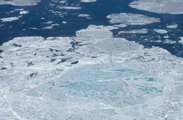- Melt pond
-
Melt ponds are pools of open water that form on sea ice in the warmer months of spring and summer. The ponds are also found on glacial ice and ice shelfs. Ponds of melted water can also develop under the ice.
Melt ponds are usually darker than the surrounding ice. The distribution and size of melt ponds is highly variable.
These ponds absorb the sun's energy, rather than reflecting it as ice does, thereby having a significant influence on Earth's radiation balance. This differential, which has not been scientifically investigated until recently, has a large effect on the rate of ice melting and the extent of ice cover. [1]
Melt ponds can melt through to the ocean's surface.[2] Salt water entering the pond, increases the melt rate because the salty water is warmer than the fresh water of the pond.
Water from melt ponds over the surface can run into crevasses or "moulin" (tubes leading under ice sheets or glaciers), turning into meltwater. The water may reach the underlying rock. The effect is an increase in the rate of ice flow to the oceans, as the fluid behaves like a lubricant in the basal sliding of glaciers.[3]
Effects of Melt Ponds
See also: Glacial motionThe effects of melt ponds are diverse. Research by Ted Scambos, from the National Snow and Ice Data Center has supported the melt water fracturing theory, that suggests the melting process associated with melt ponds has a substantial affect on ice shelf disintegration.[4] Seasonal melt ponded and penetrating under glaciers shows seasonal acceleration and deceleration of ice flows affecting whole icesheets.[5] Accumulated changes by ponding on ice sheets appear in the earthquake record of Greenland and other glaciers[6]: "Quakes ranged from six to 15 per year from 1993 to 2002, then jumped to 20 in 2003, 23 in 2004, and 32 in the first 10 months of 2005."[7] Ponding in the extreme is lakes and lakes in association with glaciers are examined in the particular case of the Missoula Floods.
-
Melt ponds on sea ice in Baffin Bay -
This false colour satellite image shows blue melt ponds in Greenland
See also
References
- ^ "Scientists use Satellite to "Pond-er" Melted Arctic Ice". NASA. 2 October, 2003. http://www.nasa.gov/centers/goddard/news/topstory/2003/0918meltwater.html. Retrieved 2008-01-01.
- ^ "Melt ponds". http://www.crrel.usace.army.mil/sid/perovich/SHEBAice/meltpond.htm. Retrieved 2008-01-01.
- ^ "Melt Ponds on Greenland's Ice Cap". http://earthobservatory.nasa.gov/Newsroom/NewImages/images.php3?img_id=17607. Retrieved 2008-01-01.
- ^ "Larsen B Ice Shelf Collapses in Antarctica". Archived from the original on 2007-12-24. http://web.archive.org/web/20071224135934/http://nsidc.org/iceshelves/larsenb2002/. Retrieved 2008-01-01.
- ^ Surface Melt-Induced Acceleration of Greenland Ice-Sheet Flow Originally published in Science Express on 6 June 2002, Science 12 July 2002: Vol. 297. no. 5579, pp. 218 - 222.
- ^ Global warming yields 'glacial earthquakes' in polar areas
- ^ Glacial earthquakes rock Greenland ice sheet 12:36 24 March 2006, NewScientist.com news service
Ponds - Ash pond
- Balancing pond
- Ballast pond
- Beel
- Cooling pond
- Detention pond
- Dew pond
- Evaporation pond
- Garden pond
- Ice pond
- Immersion pond
- Kettle pond
- Melt pond
- Mill pond
- Raceway pond
- Retention pond
- Sag pond
- Salt evaporation pond
- Sediment pond
- Settling pond
- Solar pond
- Stabilization pond
- Stepwell
- Stew pond
- Stormwater management pond
- Polishing pond
- Tailings pond
- Tarn
- Treatment pond
- Waste pond

Pools Puddles Biota - Beaver pond
- Common pond skater
- Common puddle frog
- Duck pond
- Fish pond
- Goldfish pond
- Koi pond
- Lotus
- Pond heron
- Pond lily
- Pond snail
- Pond turtle
- Pondweed
Ecosystems - Freshwater ecosystem
- Lake ecosystem
- Lentic ecosystem
- Pond ecosystem
Related topics - Aerated pond
- Bakki shower
- Big fish–little pond
- Body of water
- Full pond
- Hydric soil
- Phytotelma
- Pond aeration
- Pond of Abundance
- Pond liner
- Ponding
- The Pond
- Puddle (M C Escher)
- Spring
- Swimming hole
- Water garden
- Water Lilies (Monet)
- Water well
Categories:- Climatology
- Earth phenomena
- Ponds
- Sea ice
-
Wikimedia Foundation. 2010.



